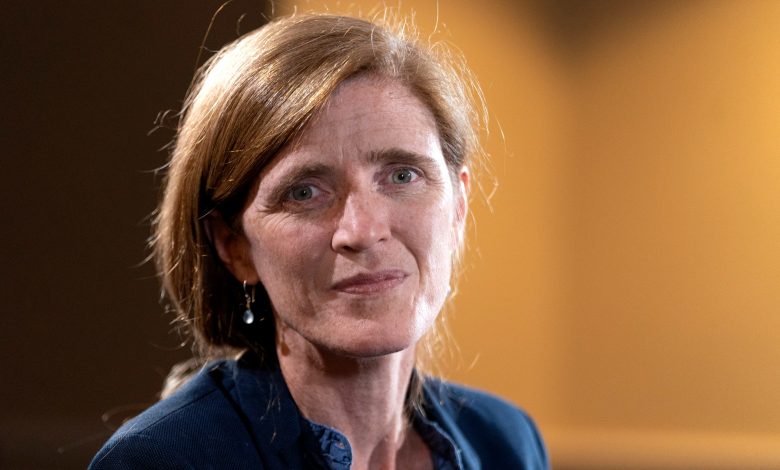Samantha Power vs. food crisis, Russia

WASHINGTON – Samantha Power won fame as a human rights advocate and was picked by President Joe Biden to lead the agency that distributes billions of dollars in U.S. aid abroad, including providing more food assistance than anyone else in the world. But since Russia invaded Ukraine, that job includes a new task with a Cold War feel — countering Russia’s messaging abroad.
As administrator of the U.S. Agency for International Development, Power is dealing now with a global food crisis, brought on by local conflicts, the pandemic’s economic upheaval, and drought and the other extremes typical of climate change. As the Biden administration spells out often, the problems have all been compounded by Russia invading Ukraine, deepening food shortages and raising prices everywhere.
That set up an hearts-and-minds competition reminiscent of the days of the Soviet Union last month, when Power visited desperate families and struggling farmers in Horn of Africa nations. She watched relief workers give emergency food to children, always among the first to die in food crises, and announced new food aid.
But unexpectedly, Russian Foreign Minister Sergey Lavrov trailed her to Africa days later, visiting other capitals with a different message meant to shore up his country’s partnerships in Africa.
It was U.S. and international sanctions on Russia over its six-month invasion of Ukraine that were to blame for cutting off vital grain supplies from the world market, Lavrov claimed. He dismissed “the so-called food crisis” on the continent being hit hardest.
In fact, a Russian blockade has kept Ukraine’s grain from reaching the world. The international sanctions on Russia exempt agricultural products and fertilizer.
“What we’re not going to do, any of us in the administration, is just allow the Russian Federation, which is still saying it’s not at war in Ukraine, to blame the latest spike in food and fertilizer prices on sanctions and on the United States,” Power, back in her office in Washington, told The Associated Press.
“People, especially when they’re facing a crisis of this enormity, they really do know the difference about … whether you’re providing emergency humanitarian assistance … or whether you’re at a podium trying to make it a new Cold War,” Power said.
“For Mr. Lavrov to have traveled to Africa just after I did, there’s almost nothing tangible in the wake of that visit that the countries he visited have obtained from him, other than the misinformation and lies,” Power said.
Even African officials whose governments refused to join in formal U.N. condemnation earlier this year of Russia’s invasion of Ukraine tell of calling Russian leaders privately to urge Russia to let Ukraine’s grain out of the ports, she said.
A former journalist, Power won the Pulitzer in 2003 for “A Problem from Hell,” a book on genocide that has fueled debates in government and among academics on the wisdom and morality of intervening in atrocities abroad ever since. She served as U.S. ambassador to the U.N. under President Barack Obama, before joining the Biden administration.
Since Russia invaded Ukraine, creating new food and energy shortfalls at a time when record numbers of people around the world were already hungry, much of Power’s focus has been on the food crisis. After an earlier decade of success slicing away at the numbers of people going without food, the estimated number of people around the world going hungry rose to 828 million this year, 150 million just since the pandemic, Power said, with many in acute need.
Even in countries outside areas where aid organizations warn of famine, high food prices are adding to political unrest, as in the overthrow of Sri Lanka’s government this summer. “Most analysts would be very surprised if the Sri Lankan government were the last to fall,” Power noted.
“The cascading political effects and the instability that stems from economic pain and people’s need, the human need, to hold authorities accountable for what is a terrifying inability to look out for the needs of your loved ones — that is a motivator if there ever is one” to protest, Power said.
“This, I can’t say it more starkly, is the worst food crisis of our lifetimes,” Power said.
There have been some hopeful signs in recent weeks, she pointed out — Russia allowing Ukraine to send its first ship of grain in months out of a Russian-blockaded port, and an easing of food and fuel prices.
But in the East Africa states hardest hit — Ethiopia, Kenya, and Somalia — four rainy seasons in a row failed, withering grain in the field and killing hundreds of million of livestock that were the only support for the region’s herders. “They don’t have a Plan B,” she said.
A woman farmer in Kenya told her of recoiling at the high price of fertilizer, and realizing she could only plant half as much food for the next season, a warning of even deeper hunger coming.
But donor assistance for Africa’s current hunger crisis is running at less than half of that for the last major one, in 2016, Power said. With no sign of an end to the war in Ukraine or to the food crisis, wealthier countries tell Power they gave much of their relief money to Ukraine and are otherwise tapped out.
Tellingly, a GoFundMe-run account that Power announced in mid-July for ordinary people to help out in the global food crisis showed just $2,367 in donations on Friday.
Power and other U.S. officials increasingly urge China, in particular, to give more relief. The Chinese Embassy in Washington, asked for comment, said China had given $130 million to the U.N. Food and Agriculture Organization.
“That’s not a talking point,” Power said of the request to China. “That’s a sincere hope.”




